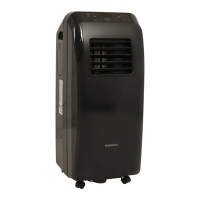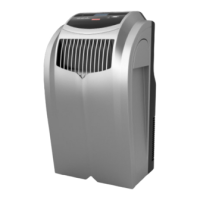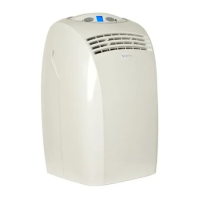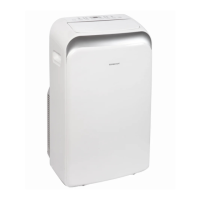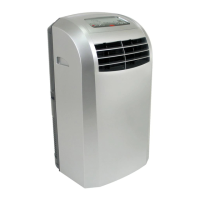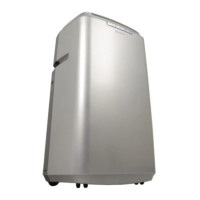Do you have a question about the EdgeStar AP10000HW and is the answer not in the manual?
Guidelines for safe electrical operation and precautions for the unit.
General safety precautions for using the portable air conditioner.
Instructions to test the Leakage-Current Detection and Interruption (LCDI) safety plug.
Section for recording model number, serial number, and date of purchase for warranty.
Steps to take before contacting customer service for assistance.
Identification of front and back components of the air conditioner unit.
List and identification of included accessories for the portable air conditioner.
Identification and function of all buttons and indicators on the control panel.
Procedure for powering the air conditioner unit on and off.
How to select between Automatic, Cooling, Heating, or Fan modes.
Adjusting the desired temperature and fan speed settings.
Setting the timer for automatic shut-off or power-on.
Information on using the heating function and its operating range.
Explanation of buttons and functions available on the remote control.
How to adjust the louvers to control the air flow direction.
Important notices regarding compressor life, mode changes, and anti-frost function.
Steps for emptying the internal water reservoir when it is full.
Instructions for setting up continuous drainage using the drain tube.
Guidance on extending the drain tube and best practices for drainage.
Instructions for cleaning the unit body, control panel, and pre-filter.
Steps to prepare the air conditioner for storage.
Tips and advice for achieving optimal performance and efficiency.
Steps to resolve issues when the air conditioner is not functioning.
Troubleshooting guide for when the unit is not cooling effectively.
Resolving issues related to loud noises, tripping power cords, or blinking lights.
Troubleshooting steps for when the air conditioner is leaking.
Details on what parts and conditions are covered by the warranty.
Limitations and exclusions from the warranty coverage.
Explanation of how warranty service is performed (repair/replacement).
Procedure and contact information for obtaining warranty service.
Guidelines for safe electrical operation and precautions for the unit.
General safety precautions for using the portable air conditioner.
Instructions to test the Leakage-Current Detection and Interruption (LCDI) safety plug.
Section for recording model number, serial number, and date of purchase for warranty.
Steps to take before contacting customer service for assistance.
Identification of front and back components of the air conditioner unit.
List and identification of included accessories for the portable air conditioner.
Identification and function of all buttons and indicators on the control panel.
Procedure for powering the air conditioner unit on and off.
How to select between Automatic, Cooling, Heating, or Fan modes.
Adjusting the desired temperature and fan speed settings.
Setting the timer for automatic shut-off or power-on.
Information on using the heating function and its operating range.
Explanation of buttons and functions available on the remote control.
How to adjust the louvers to control the air flow direction.
Important notices regarding compressor life, mode changes, and anti-frost function.
Steps for emptying the internal water reservoir when it is full.
Instructions for setting up continuous drainage using the drain tube.
Guidance on extending the drain tube and best practices for drainage.
Instructions for cleaning the unit body, control panel, and pre-filter.
Steps to prepare the air conditioner for storage.
Tips and advice for achieving optimal performance and efficiency.
Steps to resolve issues when the air conditioner is not functioning.
Troubleshooting guide for when the unit is not cooling effectively.
Resolving issues related to loud noises, tripping power cords, or blinking lights.
Troubleshooting steps for when the air conditioner is leaking.
Details on what parts and conditions are covered by the warranty.
Limitations and exclusions from the warranty coverage.
Explanation of how warranty service is performed (repair/replacement).
Procedure and contact information for obtaining warranty service.
| Description of Product | EdgeStar Portable Air Conditioner |
|---|---|
| Model | AP10000HW |
| Refrigerant | R22/15.2 OZ |
| Voltage / Frequency | 115 V, 60 Hz |
| Power / Ampere Consumption for cooling | 830W / 7.9 A |
| Power / Ampere Consumption for heating | 920W / 8.2 A |
| Maximum Dehumidifying Capacity | 50 pints/day |
| Fan speeds | 2 (High and Low) |
| Timer | 1- 12 hours |
| Net Weight | 51 lbs. |
|---|---|
| Dimensions | 12 3/8” x 14 1/16” x 27 15/16” (WxDxH) |
